The Chinese Urban-rural Dual Economic Structure Model and Analysis
Xiuchuan XU,Shengping SHI,Qinghua HUANG
1.College of Economics and Management,Southwest University,Chongqing 400715,China;2.Agricultural Education Development Research Center,Chongqing 400715,China
1 Introduction
Since the reform and opening up,China has maintained an average of nearly double-digit economic growth,the there has been a substantial increase in per capita income levels,and the overall national strength has been significantly enhanced.But the economic structural contradictions emerging along with the rapid economic growth can not be ignored;the continuing widening income gap between urban and rural areas,slow urbanization,and prominent dual economic structure,are increasingly becoming a constraint on China's sustained economic growth.According to the data of China Statistical Yearbook,it is calculated that since the focus was changed from city to village in1985,the intensity of urban-rural dual structure in China rose from 4.18 in 1985 to 6.57 in 2003(highest),and it was5.14 in 2008.The income gap between urban and rural residents rose from 2.53∶1 in 1979 to 3.23∶1 in 2011 after the reform and opening up.
From factor income distribution theory,the large labor productivity gap between urban and rural are as will inevitably lead to the huge income gap between urban and rural areas in the initial distribution.Furthermore,the urban bias fiscal policy,investment,credit,social welfare,public services and infrastructure have made the urban and rural per capita income and the level of benefits actually higher than the level of income and expenses on the book.Li Shi(2004)believed that if the physical assert incomes and various subsidies were also counted in personal income of urban residents,the urban-rural income gap in China was perhaps the highest in the world.
Based on the above reality and background,this article attempts to answer the following questions through theoretical and empirical researches,in order to find a theoretical basis for cracking the urban-rural dual economic structure,and reducing the income gap between urban and rural areas:(i)How did the logic of increasingly solidified urban-rural dual economic structure in China form after the reform and opening up?(ii)How to crack the urban-rural dual economic structure?
2 Literature review
There are rich theoretical and empirical researches on the urban rural dual economic structure at home and abroad,and different assumptions can derive different conclusions.Lewis(1954)proposed the first urban-rural dual structure model,and believed that the agricultural sector workforce endlessly flowing into the industrial sector was not only the motivation for economic development,but also the result of economic development.Ran is and Fei(1961,1964)regarded the agricultural surplus as a prerequisite of the labor transfer and industrial development.Jorgenson(1961)believed that the allocation of labor between urban and rural are as was the necessary conditions for economic development,and the industrial growth was not determined by the surplus agricultural labor force,but determined by the agricultural surplus products.Esfahani and Salehi-Isfahani(1989)gave up the hypothesis of Lewis,Todaro and other classic models that wages were exogenously given in the industrial sector,and from the adverse selection,re-develop the urban-rural dual economic labor mobility model.Yang(1997)and Rozelle et al(1999)carried out empirical test on the impact of land ownership cost on the Chinese labor migration.Chis wick(2000)considered the role of human capital in the model,and re-verified the empirical study of Yang(1997),denying the hypothesis of labor transfer opportunity cost and direct cost having no significant impact(Cai Fang,2003).Johnson(2000)summarized the three major policies responsible for widening the gap between urban and rural areas,including the restricted flow of urban and rural population,more difficult access to education opportunities for rural areas,and the urban bias of investment and credit.The empirical studies of Yang and Zhou(1999)showed that the labor productivity differences between sectors and great labor flow obstacle were the main reason for the widening gap between urban and rural areas in China since 1985.Yang(1999)ascribed the widening gap between urban areas to the urban bias policies,including higher city subsidies,investment and bank credit.The studies of Zhang and Song(2003)showed that the transfer of rural labor to urban areas was a major source of China's urban population growth.
The causality test shows that the economic growth does Granger cause population flow,but the population flow does not Granger cause economic growth.Silveira et al(2006)used the numerical simulation method to establish a two-sector model of urban and rural areas,and assume the labor migration decision as a process of discrete choice,and the simulation results show some common features of the developing countries and some emerging economies,such as persistent population growth,the wage convergence in the urban-rural sectors(Harris-Todaro equilibrium conditions),urban conglomeration and increase in the per capita income.Ryo Itoh(2009)established a two-sector dynamic optimal control model with externalities based on underdeveloped economies,for analyzing the fact that central government department took the population distribution and configuration policies,taxes and subsidies policies in the sectors as the control variables,in order to achieve the optimal control goal of urbanization.
In short,the existing studies on urban-rural dual economic structure pay no attention to the characteristics of China's existing urban-rural dual structure and the flow of migrant workers,and there are few analyses or the analyses are too simple,on the dynamic endogenous dual economic structure model.This paper attempts to build a dynamic endogenous urban-rural dual economic structure model closely linked to China's reality,to research the increasingly fixed logical basis of urban-rural dual economic structure in China since the reform and opening up,and provide a theoretical basis for proposing the recommendations for cracking the urban-rural dual economic structure.
3 Mathematical analysis of urban-rural dual economic structure model in China
3.1 Model hypothesisStarting from the first urban-rural dual structure model of Lewis(1954),all the models on urban-rural dual structure assume there are two different economic sectors in the dual economy,and this paper follows this hypothesis.According to China's specific national conditions,this paper makes the following hypotheses of simple dual economic structure model:
(i)Assuming there are two economic sectors in the economy,one is the modern urban sector,and the other is the traditional rural sector.The city produces industrial goods and the village produces agricultural products.(ii)The production function is Cobb-douglas function form,and there are constant returns to scale for the factors.(iii)Labor is fully mobile and the circulation cost is zero.(iv)The marginal productivity of labor in rural areas is not zero,and the urban and rural labor is equally treated.After entering the city,the rural labor can get the same wage incomes as the urban sector.(v)The product market and labor market are fully competitive,and the market transactions can only accept a given equilibrium price.
3.2 Model and its optimization problem sIn this paper,we comprehensively consider the R&D model of Romer(1990)and human capital model of Mankiw,Romer and Weil(1992)as the basic analysis framework for dynamic endogenous dual economic structure model.
Let the production function of urban and rural sectors be as follows:

where Q1and Q2are industrial output and agricultural production,respectively;A1and A2are the technical factors of the two sectors,respectively,which mean the stock of knowledge,technology,innovation and other factors;K is the physical capital input in the urban sector;D is the land and physical capital input in the rural sector;l is the amount of labor for the whole society;φis the proportion of urban labor to social labor;H1and H2are the human capital stock of urban and rural sectors,respectively,embodied in the knowledge and skills of workers;α1,α2,α3,β1,β2,β3>0,and they are the output elasticity of various factors.
The increase in the physical capital stock K of the urban sector is from the new investment,denoted by K:

where SKis the proportion of output used for physical capital accumulation;ωis the proportion of output used for nurturing the agricultural capital input;δkis the depreciation rate of capital;K0is the initial capital stock.
The land and physical capital stock of rural sector is from the land use within the rural sector and input of industrial sector to agriculture and its increment is signified by
Let D=dωK,where d is the contribution from the effective use area of land(assumed to be constant);ωK is the contribution from industry nurturing,and the land capital decreases or depreciates at the ratio ofδD;D0is the initial land and physical capital stock.

The increase in the human capital stock of urban sector is from human capital investment,and the human capital inflow of rural sector,denoted by;the human capital accumulation in the rural sector is from itshuman capital investment,but there isa certain percentage of the flow of human capital in rural areas to urban sector,denoted
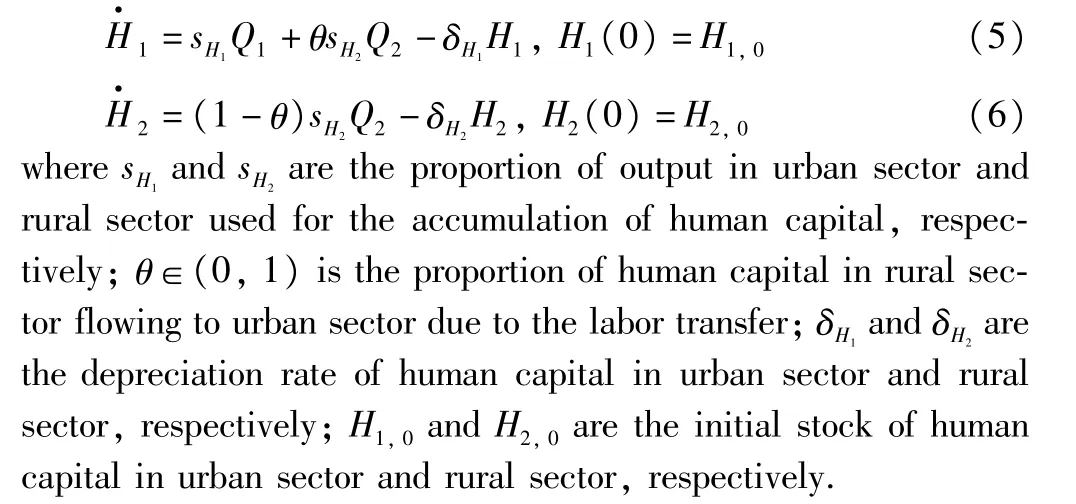
Due to the human capital input,the knowledge will continue to accumulate over time,and new knowledge and technology are created,but the knowledge is also outdated,so there is:
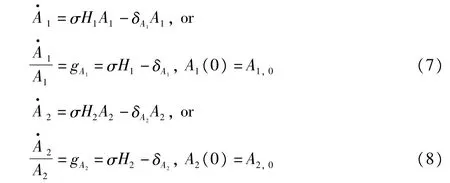
where σ is research and development(R&D)parameter(σ is constant,orσ=σ(t),that is,σ may be or not be variable about time,and in order for simplification,this paper let the σ be constant.);the depreciation rate of knowledge;A1,0and A2,0are the initial stock of knowledge in the urban and rural sector.
Assuming the initial number of labor force is L(0)=L0,the proportion of urban labor to total social labor isφ(0)=φ0,φ=φ(t),is the variable about time,and the growth rate of total social labor is constantly n,namely:
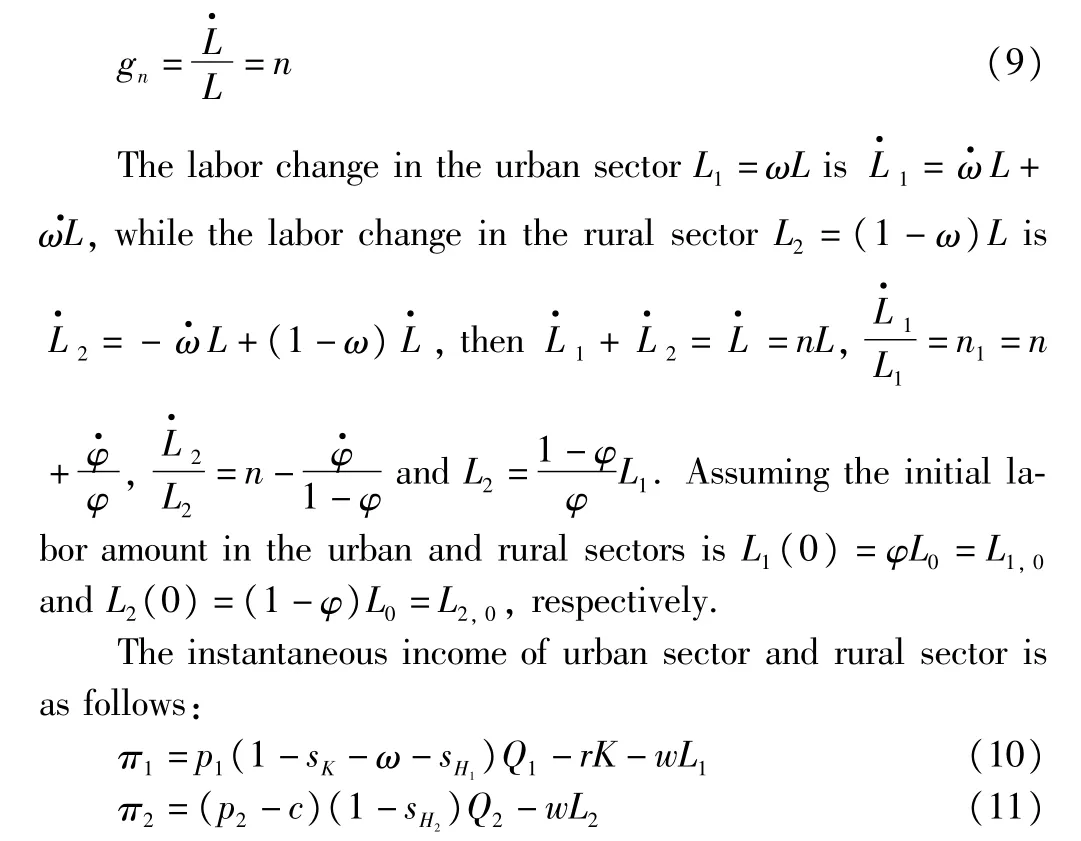
where π1and π2are the net income of urban and rural sectors,respectively;p1is the prices of industrial goods;p2is the prices of agricultural products;c is the unit cost of agricultural products;r is the capital interest rate;w is the wage level in the urban sector.
To make the analysis simple,the two sides of formula(10)are divided by p1at the same time,and the two sides of formula(11)are divided by p2-c,namely the prices are normalized.Let α=(1-sK-ω-sH1)and b=(1-sH2),then:

where π′1,r′and w′are the true level of income,effective interest rate and efficiency wages in the urban sector,respectively;π′2and w″are the true income and true opportunity cost of unit labor in the rural sector.
The income maximization objective in the urban sector is as follows:
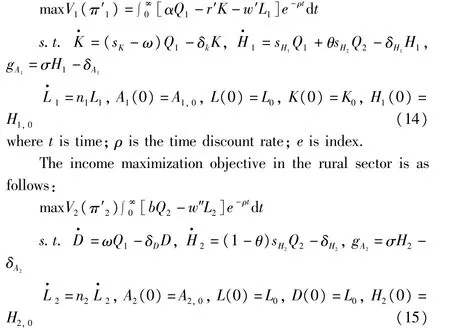
3.3 The optimal equilibrium conditions of modelFor the income maximization problem in the urban sector,Lagrange multipliers are introduced to change it into unconstrained variational problem:

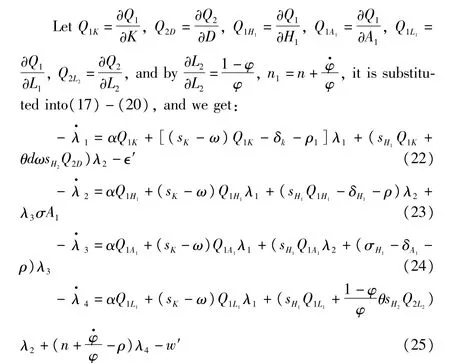
The solution of formula(21)is just the constraint on four differential equations of production factors of the optimization problem(14),so the optimal necessary condition is fully determined by the four constraints of(22)-(25)and(14).This is a set of8-dimensional nonlinear differential equations,and it is very difficult to solve the equilibrium point of the higher order equation set by symbolic computation,and also difficult to linearize it at the equilibrium point and carry out qualitative analysis of the stability.Therefore,this article is not intended to discuss the equilibrium point and its stability.However,the generalized Lagrange multiplier λirepresents the opportunity cost or shadow values of factor i,so the formula(22)to(25)reflects the effects of changes in the shadow values in the production decision path of income maximization.),represents the rate of decrease of opportunity cost(shadow value)of factor i with time,so if-the opportunity cost of factor will decrease faster,and the factor will make greater contribution to income,thus the factor becomes more important.
Formulas(22)to(25)are similar:
(i)The first term of all equations is a multiplied by marginal productivity of factor.From the foregoing,α=(1-sK-ω-sH1),namely a is the proportion of products for sale.Since prices have been normalized,the marginal productivity of factor is the marginal income of factor.Thus,the first term of the above formulas represents the contribution of marginal productivity of various factors to income.For the remaining terms,if the sign is positive,it means the contribution to income;if the sign is negative,it means the deduction of income.
(ii)Any quantity associated with the product distribution share is to be multiplied by the marginal productivity of factors,representing the effects of changes in factor share on the income through the marginal productivity of factors,such as α,sK,sH1,ω and θ.In this article,it is referred to herein as the share quantity.
(iii)Except the first term of the equation,any quantity formed by multiplying share quantity and marginal productivity,is to be multiplied by one certain,indicating that except a,the changes in the remaining share quantities will have accumulation and interaction effects on the income of the sector.
(iv)The real interest rate of capital r′and efficiency wage rate w′represent the direct cost to income,called the direct cost quantity;the sum of discount rate ρ and depreciation rate(δk,δH1,δA1)is to be multiplied by the shadow price of factors,constituting the deduction of income.This article calls it the indirect cost quantity,and the population growth rate n is the indirect income quantity.
(v)Research and development(R&D)parameter is the exogenous parameter,and the proportion of urban labor to social labor is the endogenous function.
In the same way,we can solve the income maximization problem of the rural sector(15).For the problem(15),Lagrange multipliers are introduced to change it into unconstrained variational problem:Lagrange multipliers are introduced to change it into unconstrained variational problem:
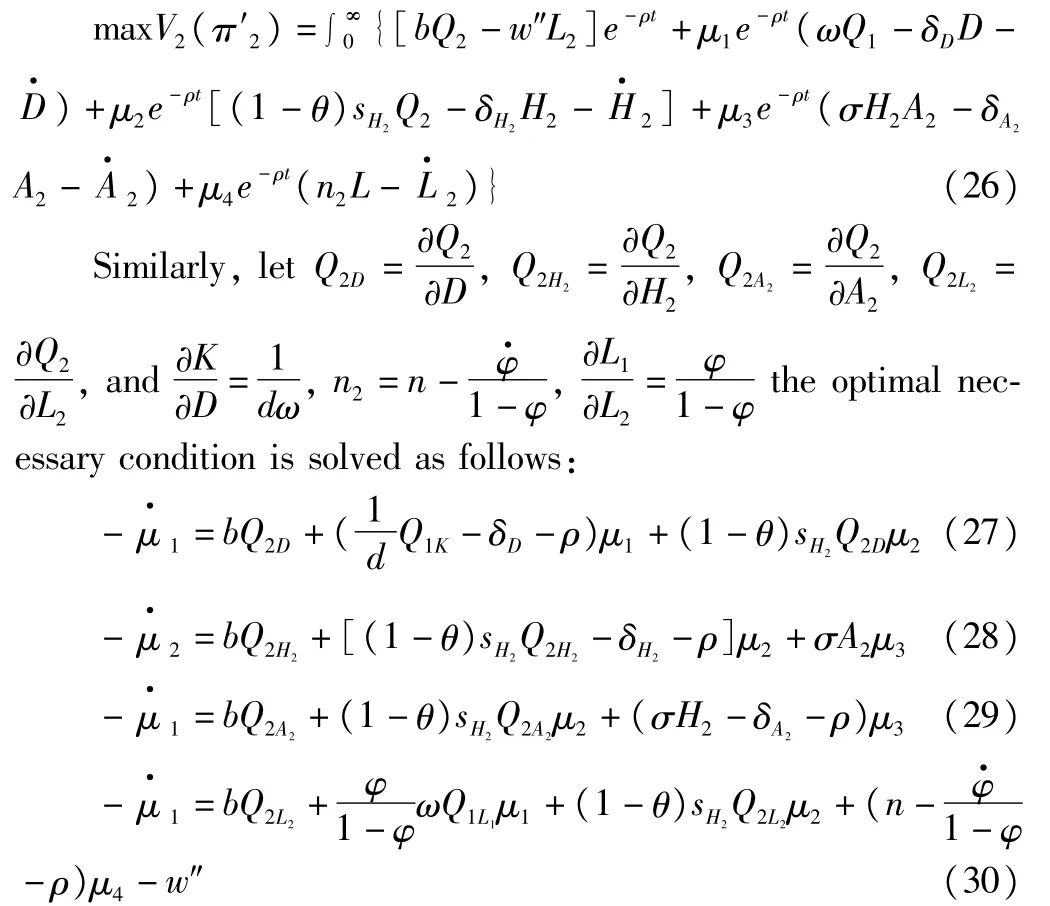
3.4 The optimal model conditions and analysisFirstly,we analyze the physical capital factor.From(22),we can find that the feeding of urban capital on the countryside will make the coefficient of its contribution to income undergo ωQ1Kunits of decline,but as long as(sK-ω)Q1K-δk-ρ>0,namely when the product of the share of urban sector used for the final capital accumulation and the marginal productivity of capital is greater than the sum of the depreciation rate and the time discount rate,the capital factor can still contribute positively to income.The human capital factor flowing from the rural sector makes θdωsH2Q2Dunits of contribution to the income of urban sector,and it is combined with λ2to form positive feedback.
From(27),we can find that when the nurturing capitalof urban sector for per unit area of land in rural sector is greater than the sum of rural land capital depreciation rate δDand time discountthe land capital factor of rural sector can make positive contribution to income.Otherwise,due to the deterioration of the land capital factor,there will be a vicious cycle of decline in income in rural sector.Actually,the feeding mechanism of urban sector for rural sector is necessary.
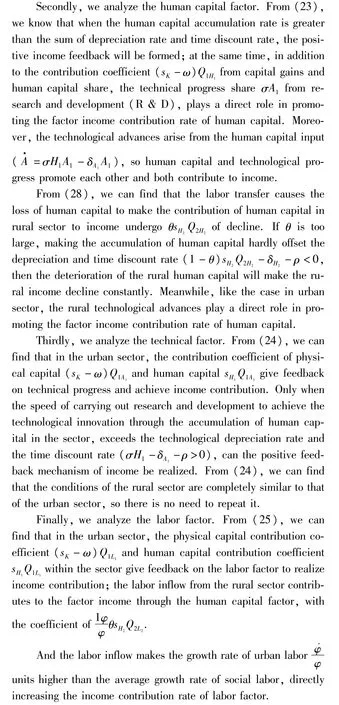
From(30),it shows that the income contribution rate of the corresponding labor factor in the urban and rural sectors is similar,but due to the labor outflow from the rural sector,the growth rate of rural labolower than the average growth rate of social labor,directly offsetting the income contribution rate of labor factor.
3.5 The logic of solidified urban-rural dual economic structure in ChinaIn terms of physical capital,due to the urban bias fiscal policy,China has not formed industry nurturing agriculture on a large scale,and the government financial support for agriculture is not sufficient;because of the lack of the formal financial system in rural areas and credit rationing,there is a shortage of rural funding sources,and the physical capital input in rural China is grossly inadequate.
In terms of human capital,if the young generation in rural China are admitted to the university,they almost do not go back to the rural areas for farming,which is a reason for the loss of skilled labor in rural areas.Moreover,the rural areas with lower income have too many difficulties to cope with the high cost of education,and affected by the level of education in rural areas,education environment and other factors,the young people in the rural areas are likely to work outside the home because of family difficulties during high school,and they participate in the labor prematurely.Compared with urban residents,there is a significant gap in the human capital investment.
Since the farming income is generally lower than the income from working outside,most of the young rural laborers work outside the home,leaving only the elderly,children and women in rural areas.Thus,the increasingly solidified vicious cycle of urban-rural dual economic structure can be expressed as:
path dependence of production system'small-scale family operation'extensive agricultural production'urban-rural income gap'labor transfer'widening quality gap between urban and rural labor'widening comparative labor productivity gap between urban and rural areas'factor input gap between urban and rural areas'extensive agricultural production……
3.6 Model resultsThrough the dynamic optimal necessary conditions two-sector production,we draw the following conclusions:
(i)For the economic production in various sectors,except the labor factor,only when the accumulation rate of other factors of production is greater than the sum of depreciation rate and time discount rate,can the positive feedback of income be achieved,otherwise there will be a vicious cycle of diminishing returns.The growth rate of labor in various sectors must be greater than the time discount rate,r else there will also be a vicious cycle of diminishing returns.(ii)If the accumulation rate in the rural sector is low and the land physical capital input in the rural sector is only from the feeding of the urban sector,then when there is depreciation in the rural land and physical capital,a vicious cycle of insufficient accumulation and declining income will occur.(iii)Similar to physical capital,due to the labor outflow,the human capital of rural sector flows into urban sector,so the rural areas are prone to the fact that human capital accumulation is insufficient to offset depreciation,which will lead to a decline in rural income.In the reality,the considerable outflow of rural young labor leads to the outflow of rural human capital,and based on the model'sequilibrium conditions of this section,we get the theoretical point of view of vicious cycle of increasingly solidified urban-rural dual economic structure.(iv)From the set of four differential equations of balanced necessary conditions of various sectors,we can find that there is interaction among physical capital,human capital,technological progress,labor number and other factors,and the impact of these factors on income will be passed to other factors through the accumulation of final gains,thus affecting the final income.
Especially in light of R&D model hypothesis,technological advances are from the accumulation of human capital,strengthening the role of human capital factor in the income of sectors.Thus,to narrow the economic gap between urban and rural areas,it is necessary to change the urban bias fiscal and financial systems,greatly enhance the physical capital and human capital input in rural areas to prevent the rural human capital from excessively flowing into urban sector,and strengthen the intensity of industry nurturing agriculture.
4 Conclusions
This article builds a dynamic endogenous urban-rural dual economic model closely linked to China's reality,and carries out mathematical economics analysis of optimized conditions for urban and rural sectors.The results show that the labor growth rate of urban-rural sectors must be greater than the time discount rate,or else there would be a vicious cycle of diminishing returns in the sectors;the accumulation rate of physical capital and human capital of urban-rural sectors,and the rate of technological progress,need to be greater than the corresponding depreciation rate plus the time discount rate,otherwise there would be a vicious cycle of diminishing returns in the sectors;the low accumulation rate in the rural sector,and the occurrence of labor outflow,human capital loss and lack of investment,will expand income gap between urban and rural areas,which is a reason for solidification of urban-rural dual economic structure.
Therefore,to avoid the widening income gap between urban and rural areas,it is necessary to strengthen the degree of industry nurturing agriculture,and increase rural factor inputs to form a virtuous cycle of urban-rural input and output,ultimately achieving the goal of reducing the income gap between urban and rural areas and weakening the urban-rural dual economic structure.
[1]LIS.A review of income inequality in China[DE/OL].Academy of Macroeconomic Research,NDRC,2004-03-09.(in Chinese).
[2]Lewis WA.Economic development with unlimited supplies of labor[J].Manchester School,1954,22(2):139-191.
[3]Ranis G,Fei J.C.H.A theory of economic development[J].American Economic Review,1961,51(4):533-565.
[4]Jorgenson RF.The development of a dual economy[J].Economic Journal,1961(71):309-334.
[5]Johnson DG.Reducing the urban-rural income disparity[C].Paper no.00-07,Office of Agricultural Economics Research,The University of Chicago,2000.
[6]Yang,DT,Zhou H.Rural-urban disparity and sectoral lab our allocation in China[J].Journal of Development Studies,1999,35(3):105-133.
[7]Yang DT.Urban-based policies and rising income inequality in China[J].The American Economic Review(Nashville),1999,89(2):306-310.
[8]ZHANG KH,SONG SF.Rural-urban migration and urbanization in China:Evidence from time-series and cross-section analyses[J].China Economic Review,2003(14):386-400.
[9]Silveira JJ,Aquino L.Espindola,T.J.P.Penna.An agent-based model to rural-urban migration analysis[J].Physica,2006(A 364):445-456.
[10]Ryo Itoh.Dynamic control of rural-urban migration[J].Journal of Urban Economics,2009(66):196-202.
[11]Knight J,Ramani Gunatilaka.Great expectations The subjective well-being of rural-urban migrants in China[J].World Development,2010,38(1):113-124.
[12]CHEN ZS,LIDF.A growth model of a dual economy with endogenetic agricultural productivity growth——The re-interpretation of the Chinese and East Asian Miracle[J].Economic Research Journal,2004,(11):16-27.(in Chinese).
[13]GUOT,SONGDY.A endogenous growth model of dual economy about rural labor transfer[M].South China Journal of Economics,2006(8):77-80.(in Chinese).
[14]Romer PM.Endogenous technological change[J].Journal of Political E-conomy,1990,98(10):71-102.
[15]Mankiw NG,David Romer,David Weil.A contribution to the empirics of economic growth[J].Quarterly Journal of Economics,1992,107(2):407-427.
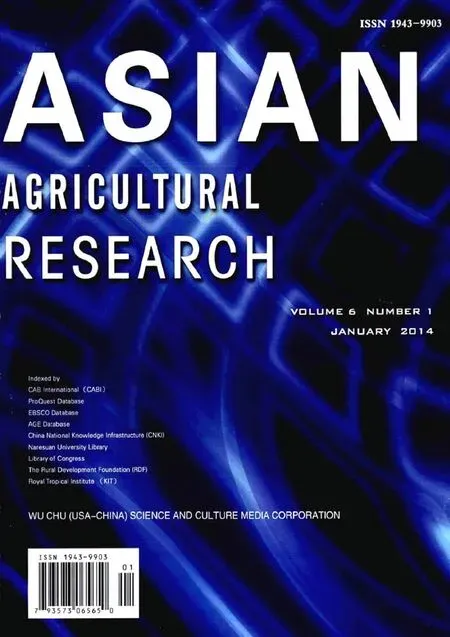 Asian Agricultural Research2014年1期
Asian Agricultural Research2014年1期
- Asian Agricultural Research的其它文章
- Study on Performance of Development of Sports Industry in China-Based on DEA Nonlinear Estimation
- Comparative Analysis of the Purchase Price of Raw M ilk in the World
- Com parative Research of Residents'Effect Perception and Participation Capacity and Willingness on Pro-poor Tourism
- Study on the Supply Efficiency of Rural Public Service in China Based on Three-stage DEA M odel
- Research on the Peanut Leaf Etiolation Prevention and Film M ulching Effect in Hubei Province
- Consumers' Perception of Risks,Awareness of Products and Willingness to Pay:A Case Study of Organic Milk
